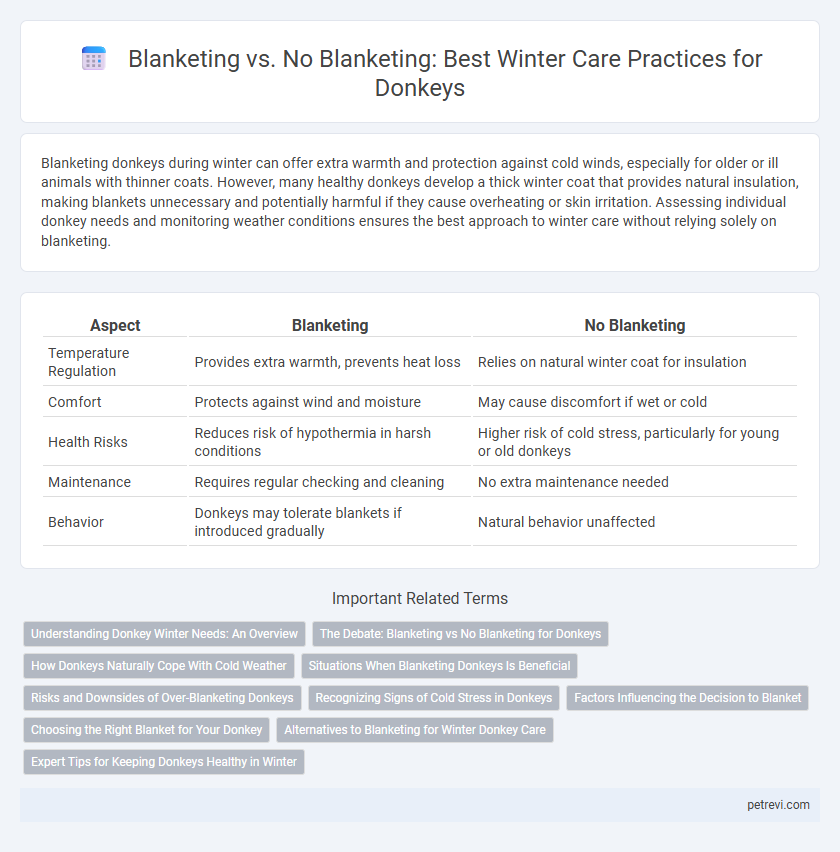Blanketing donkeys during winter can offer extra warmth and protection against cold winds, especially for older or ill animals with thinner coats. However, many healthy donkeys develop a thick winter coat that provides natural insulation, making blankets unnecessary and potentially harmful if they cause overheating or skin irritation. Assessing individual donkey needs and monitoring weather conditions ensures the best approach to winter care without relying solely on blanketing.
Table of Comparison
| Aspect | Blanketing | No Blanketing |
|---|---|---|
| Temperature Regulation | Provides extra warmth, prevents heat loss | Relies on natural winter coat for insulation |
| Comfort | Protects against wind and moisture | May cause discomfort if wet or cold |
| Health Risks | Reduces risk of hypothermia in harsh conditions | Higher risk of cold stress, particularly for young or old donkeys |
| Maintenance | Requires regular checking and cleaning | No extra maintenance needed |
| Behavior | Donkeys may tolerate blankets if introduced gradually | Natural behavior unaffected |
Understanding Donkey Winter Needs: An Overview
Donkeys have unique winter care requirements that differ from horses due to their native arid environments, making blanket use often unnecessary unless extreme cold or wet conditions prevail. Their dense coats provide natural insulation, and over-blanketing can lead to overheating or skin issues, so monitoring individual donkey behavior and environmental factors is critical. Understanding the balance between adequate warmth and avoiding excess covering ensures optimal donkey health throughout winter.
The Debate: Blanketing vs No Blanketing for Donkeys
Blanketing donkeys during winter involves weighing benefits like additional warmth and protection against potential risks such as overheating and restricted natural thermoregulation. Advocates argue that blanketing helps maintain body condition in harsh climates, while opponents emphasize donkeys' natural adaptation to cold, promoting their own coat growth and energy conservation without blankets. Careful consideration of environmental factors, donkey health, and individual needs guides the ongoing debate on blanketing versus no blanketing in winter donkey care.
How Donkeys Naturally Cope With Cold Weather
Donkeys have thick, coarse winter coats that provide natural insulation against cold weather, allowing them to maintain body heat effectively without the need for blanketing. Their dense fur repels moisture and reduces heat loss, making them more resilient to wind and wet conditions compared to horses. Blanketing can disrupt this natural defense, potentially causing overheating or skin issues if not managed carefully.
Situations When Blanketing Donkeys Is Beneficial
Blanketing donkeys during winter is beneficial in harsh climates where temperatures drop below freezing, as their sparse winter coats provide limited insulation against cold and wind. Donkeys with thin or clipped coats, older age, or health issues also benefit from blankets to prevent hypothermia and maintain body warmth. In addition, newly rescued or weakened donkeys often require blanketing to help them adapt to colder environments while their natural tolerance strengthens.
Risks and Downsides of Over-Blanketing Donkeys
Over-blanketing donkeys during winter care can lead to overheating, skin infections, and restricted movement, which compromise their health and well-being. Donkeys naturally grow thick winter coats that provide sufficient insulation, making excessive blankets unnecessary and potentially harmful. Monitoring their condition closely and using blankets only when absolutely needed reduces the risk of over-blanketing and ensures optimal winter care.
Recognizing Signs of Cold Stress in Donkeys
Donkeys show signs of cold stress through shivering, lethargy, and a rough, dull coat, indicating their need for warmth during winter. Blanketing helps maintain their core temperature by providing insulation against wind and moisture, especially for older or low-weight donkeys. Without blankets, vigilant monitoring for these symptoms is crucial to prevent hypothermia and promote overall health in cold conditions.
Factors Influencing the Decision to Blanket
In donkey winter care, deciding whether to blanket depends primarily on factors such as the individual donkey's coat thickness, body condition, and exposure to harsh weather conditions like wind, rain, and low temperatures. Older or ill donkeys with compromised natural insulation may require blanketing to prevent hypothermia, while healthy donkeys with thick winter coats often regulate their body temperature effectively without blankets. Additionally, the availability of adequate shelter and consistent access to high-quality forage influences the necessity of blanketing in cold climates.
Choosing the Right Blanket for Your Donkey
Choosing the right blanket for your donkey involves assessing its coat thickness, age, and overall health to provide optimal winter protection. Lightweight, breathable blankets made from waterproof materials help maintain warmth while preventing overheating and skin issues. Proper fitting ensures comfort and avoids chafing, while regular monitoring allows adjustments based on weather conditions and individual donkey needs.
Alternatives to Blanketing for Winter Donkey Care
Donkeys possess dense winter coats that provide natural insulation, making blanketing unnecessary in many cases. Alternatives to blanketing include providing ample shelter from wind and rain, ensuring dry, elevated bedding, and maintaining proper nutrition to support their natural thermoregulation. Regular health checks and monitoring body condition ensure donkeys remain healthy without the need for blankets during winter months.
Expert Tips for Keeping Donkeys Healthy in Winter
Blanketing donkeys in winter helps maintain their body temperature and prevents weight loss, especially for older or clipped donkeys with thin coats. Experts recommend using breathable, waterproof blankets that fit well to avoid skin irritation or restricted movement. Regular monitoring for wetness or rubbing is crucial to ensure the donkey's comfort and overall health during cold months.
Blanketing vs No Blanketing for Donkey Winter Care Infographic

 petrevi.com
petrevi.com